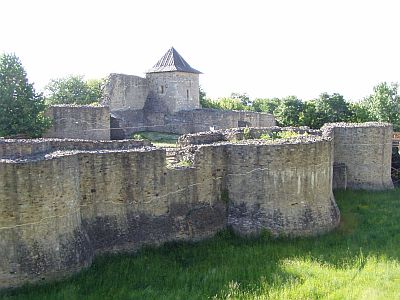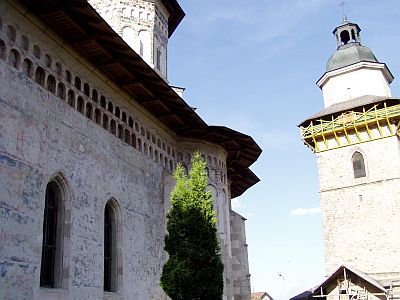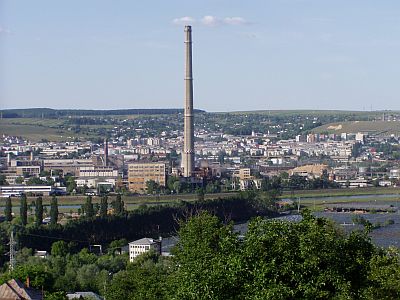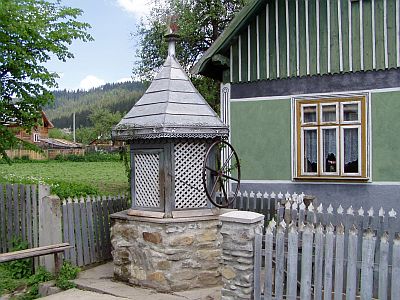|
|
|
|
|
|
 Name: Suceava (pronounced Soo-chava). No idea where the name comes from. Also, there's
no Hungarian or German version of it.
Location:
Suceava lies more than 350 km north of the capital →Bucharest in the
northern part of Moldavia - not to be confused with the nearby
→Republic of Moldova!
The northern part of Moldova is called Bucovina (lit: Land of the Beeches), with
Suceava being the centre of the Southern Bukovina. The Northern Bukovina
now belongs to the →Ukraine. The centre of the
northern part is called Chernivtsi (Cernăuţi).
Name: Suceava (pronounced Soo-chava). No idea where the name comes from. Also, there's
no Hungarian or German version of it.
Location:
Suceava lies more than 350 km north of the capital →Bucharest in the
northern part of Moldavia - not to be confused with the nearby
→Republic of Moldova!
The northern part of Moldova is called Bucovina (lit: Land of the Beeches), with
Suceava being the centre of the Southern Bukovina. The Northern Bukovina
now belongs to the →Ukraine. The centre of the
northern part is called Chernivtsi (Cernăuţi).
Suceava stretches along the river with the same name. The Carpathian Mountains start a few kilometres to the west.
The worldwide famous →Cinci Mănăstiri (Five Monasteries) are
30 to 60 away to the west.
Population: About 120,000 inhabitants. Suceava is the largest city in the
Southern Bucovina (the north-eastern corner of Romania).
Orientation:
The town is dominated by two rivers - one is the river Suceava flowing in a wide valley from
the west to the east, the other one is the tiny river Cetăţii, which follows a
deep and narrow valley from the south to the north. Many of the residential and industrial areas
occupy the wide river valley and partially stretch north of the river Suceava. The old town centre
lies south of the river Suceava and west of the Cetăţii. Opposite the Cetăţii,
you will find the fortress on the top of a hill. However, not much is left of the old town - most buildings
are relatively new and not very attractive concrete structures. This can be said about the
central square Piaţa 22 Decembrie, too. The main bus station is only
300 metres away from the square. Suceava has more than one train station. The most important one is
the Gara Suceava Nord, which is many kilometres away from the centre of town, so you
will have to take a bus or a taxi.
Getting there:
The express train (accelerat) from →Cluj-Napoca via
→Vatra Dornei to →Iaşi and Galaţi
stops in Suceava Nord. From Cluj, it takes more than 7 hrs (around 250,000 Lei, € 8), from Vatra Dornei
3 hrs (124,000 Lei), to Iasi it's less than 2 hrs (70,000 Lei). There are also daily direct trains to
→Bucharest. Needless to say that there are also countless long-distance
bus connections. There's one daily bus (no service on Sundays!) from Suceava via
Botoşani to →Bălţi in the
→Republic of Moldova. Additionally, there are also buses to
Chernivtsi in the →Ukraine. Note that most nationalities
require a visa for the Ukraine as well as for Moldova!
For detailled information on how to get to the monasteries see →Cinci Mănăstiri.
|
|
|
|
|
|
|
Suceava has a long and glorious history, but again - there's not much left of it. The town was first mentioned in the 14th century and
became the capital of Moldavia between 1388 and 1565. Additionally, it was an important market town along the trading route between
→L'viv (Lvov) and →İstanbul. From
Suceava, the legendary national hero Ştefan cel Mare (Stephen the Great), living from 1457 to 1504, ruled
Moldavia successfully - that period can be called Moldavia's heyday. Since 1565, Moldavia was occupied by the Ottoman Empire.
In 1775, the whole Bucovina including Suceava was taken over by Habsburg ruled Austria-Hungary.
The capital was moved to →Iaşi and so Suceava lost its status as the capital of the region. Since 1918, the region
(including the Northern Bukovina!) was a part of the newly founded Kingdom of Romania.

| |
Cetatea de Scaun a Sucevei - the fortress opposite the town |
Of course, Suceava had a strong fortress in order to protect the town. The fortress was built on the top of
a hill opposite the centre. It's called Cetatea de Scaun (City Fortress) and was built around the year
1388. The fortress even withstood an Ottoman attack in the year 1476. The walls were not less than 33 metrestall and
4 metres thick. Additonally, the fortress is surrounded by a deep moat. Inside the fortress it's rather narrow, but this was really a
mighty stronghold. Unfortunately, the castle was blown by the Turks in 1675 and finally levelled by the Austrians in 1775.
After 1944, the people tried to rebuilt parts of the fortress. You will notice a white line running along all the walls (you can see it on the
picture, too). I'm not sure whether this is true, but the white line might mark the condition of the fortress as of 1944. Admission fee is
15,000 Lei. The castle provides a fine view over the town.

| |
St Dimitru-Church: Now without frescoes
|
Almost in the centre of town, you will find the remainings of the Princely Palace from the 15th century.
However, it was completely surrounded by fences (as of June 2004) so there was absolutely nothing to see.
Within spitting distance, there's the Biserica Sfântu Dimitru (Church of St Dimitru),
built in 1535 in the Byzantine style. Inside as well as outside, the walls were covered with frescoes, resembling the marvellous
→Cinci Mănăstiri (Five Monasteries) not far from Suceava. All of the
frescoes covering the outer walls virtually vanished - today, you can only guess the former beauty of the church.

| |
Suceava has suffered a lot from industry
|
The frescoes of St Dimitru Church didn't really have a chance. The environmental pollution in and around Suceava
was literally breathtaking. There are huge factories in the river valley, among them paper producing industry which is
still operating. The factories produced tons of exhaust fumes and fibres. The situation has widely improved, but even
now you will soon notice that the air in Suceava is not clean. During the socialist times, Suceava was one of the
most heavily polluted cities in Europe. It even produced its own air-borne disease, which is referred to as the
Suceava-Syndrome. But this phenomenon is not limited to Suceava - see
→Yokkaichi (Japan) for another example.
|
|
|
|
|
|
|

| |
Typical well and traditional farmhouse in the Bukovina
|
Although heavily frequented by coach parties, a visit to the →Cinci Mănăstiri (Five Monasteries)
west of Suceava is simply a must. Suceava makes a perfect place for exploring the area.
|
|
|
|
|
|
|
As far as I've heard, it's possible to stay in very cheap and dirty rooms
inside the bus station - from outside, it looked really drab. As for the rest,
accommodation prices in Suceava seem to be much higher than in the
rest of the country. A double room in Hotel Suceava set us back
118,000 Lei per night, which is almost € 15 per person. Other hotels in the vicinity
aren't cheaper. But it's just fair to mention that the price is more than appropriate.
Rooms come with bathroom and toilet, everything is spick and span, breakfast is included. And the
location couldn't be better.
Address: Str. Bălcescu 2, Tel.: (030)-521 209.
The hotel faces above-mentioned 22 Dec Square. The hotel restaurant can't be recommended.
There's a travel agent on the ground floor arranging cars and drivers to tour the
→Cinci Mănăstiri (Five Monasteries).
If you need a break from all the corn mush, fried meat and sheep's cheese, you might opt for
Restaurant Latino opposite the bus station. The restaurant serves
authentic Italian cuisine and everything tastes almost perfect. Staff is very friendly and service
is good. Main dishes (and I'm not only talking about pasta and pizza) cost between
70,000 and 130,000 Lei (€ 2 - 3). The restaurant also has good wine and Italian espresso.
Address: Str. Curtea Domnească 9, Tel.: 523 627.
|
|
|
|
|
|
|
www.e-suceava.com
Not much contents and in Romanian only, but this website is
somehow brilliant and funny (although my Firefox had a problem with it)
www.filadelfia.ro/albumfoto/suceava
A few pictures, unfortunately without explanation, from Suceava.
Do you have or do you know a good website about Suceava? Don't hesitate, let me know!
After checking it, I would love to add it to the link list.
Please note that commercial websites will be declined. For e-mail link see menu on the left.
|
|
| |